1972 Argentine Grand Prix race report
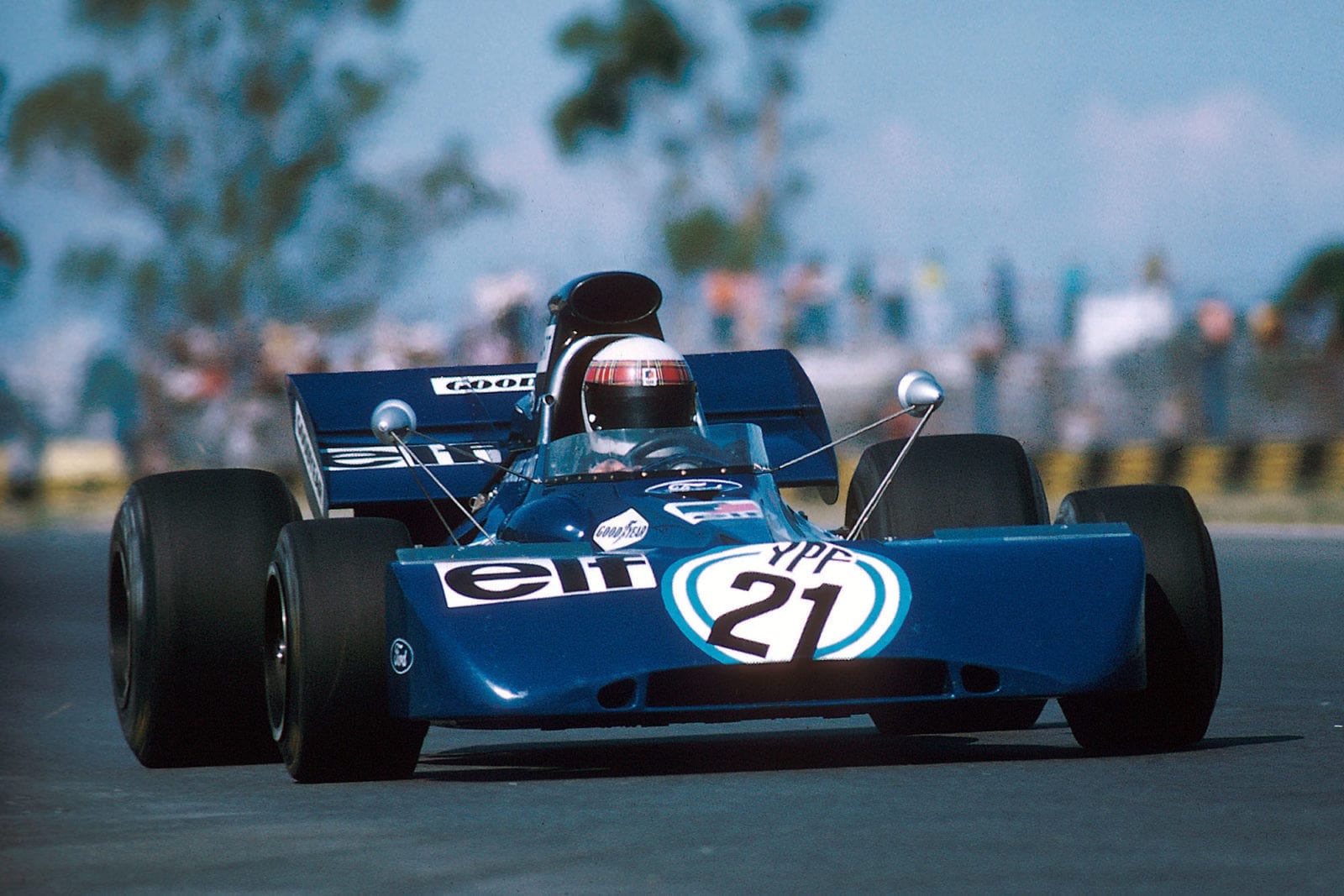
Jackie Stewart continued Tyrrell's winning ways by taking 1st place in Buenos Aires
Motorsport Images
Tyrrell-Cosworth and Stewart still supreme
Buenos Aires, January 23rd.
For the first time, since the beginning of the 3-litre Formula One, the season started in Argentina in January rather than in South Africa in March; in fact it was the first World Championship Formula One race in this torrid South American country for 12 years. The venue, however, was the same, the impressive Buenos Aires Autodrome on the outskirts of the federal capital.
The facilities at Buenos Aires always were good but now they are absolutely superb, almost coming up to the Paul Ricard/Ontario standards when it comes to garage accommodation. The rebuilding of the circuit, plus the construction of Balcarce and the general underwriting of the series, was in the hands of the YPF Club, which is the social section of the giant national fuel company, which receives government money for the purpose. For the Formula One race it had been decided to use the 3.41-km., No. 9 circuit which is considerably shorter and more twisty than the No. 15 track used for the sports-cars race. The Autodrome, which is sited in a big park, has a whole complex of circuits although some are no longer usable.
The organisers selected a field of 22 cars including all the works teams, except Tecno who were not ready for this event, but the only private owner was Frank Williams. All the cars were transported in two giant swing-tail Tradewinds Airways prop jets and the plan was to fly the cars on to South Africa after the race, where they would either lay in store until March or, as in most cases, take part in various test programmes prior to the Grand Prix. The Argentinians decided on their own numbering system which consisted of putting all the works cars in alphabetical order. Thus, top of the list came the two works Brabhams of Graham Hill and the Argentinian Carlos Reutemann. The team was very much under new management with managing director Bernard Ecclestone present, along with team manager Keith Greene, ex-McLaren designer Ralph Bellamy and a recently recruited chief mechanic, but Ron Tauranac stayed at home. The colour scheme had been changed to white and Hill, who rejoined the team at the last minute, had decided to use the 1970 model BT33/3 raced by Schenken last year. This had been re-skinned in 16-s.w.g. aluminium, had new type shock-absorbers and brakes, had been generally tidied up, and was using the new type front body introduced for the last race of 1971. Thus Reutemann inherited the later BT34 model which also had some detailed changes including a new bodywork around the cockpit. He is, of course, a permanent member of the team following his fine performances in Formula Two last season, while the Argentinian Automobile Club have also been able to offer financial incentive to ensure his place.
Next on the list were the BRMs and no fewer than five of the Marlboro-sponsored cars had been accepted. Because of the possible repercussions following Beltoise’s incident in the sports-car race last year it was decided to postpone his debut with the team until South Africa and give the former Lotus No. 2, Reine Wisell, a drive on this occasion. The oversize team brought along the two slimline P160s from last year plus a brand new one which was to have been Beltoise’s early season car, plus a couple of 1970 P153s. All the P160s were to a “B” specification which includes four fuel cells instead of two, Lockheed instead of Girling brakes, eared knock-on front wheel nuts, wider cockpit and what is virtually the rear suspension which will be fitted to the new P180s when they appear. This includes new uprights and suspension parts, giving a wider rear track, while all the BRMs had cold air boxes; the first time they have been so fitted. Both Peter Gethin and Howden Ganley had their regular P160 cars from last year and they, along with WiseII, who was driving a P153, were entered simply by Marlboro-BRM. The Spaniard Alex Soler-Roig was entered by Espana-Marlboro-BRM and entrusted with the brand new P160, while Helmut Marko, who drove the last four races for the team in 1971, was entered by Austria-Marlboro-BRM and had a P153.
After their unexpectedly dismal showing last season Ferrari were all set to make amends and had retained on their books drivers Jacky Ickx, Clay Regazzoni and Mario Andretti. All, basically, were allocated the same cars they had last year but all three had been completely revised in the suspension department. The inboard horizontally mounted rear suspension system had been thrown away and replaced with a completely conventional wishbone and link system. This gave a wider track and, according to the drivers, made the car much easier to set up. At the front there was inboard suspension as before but giving a wider track and different geometry, and in the winter efforts had been made to improve the reliability of the engines.
Next on the list were John Player-Team Lotus with the cars they prefer to call John Player Specials but we know as Lotus 72s. In fact last year’s two cars had been very little altered apart from the black and gold paint job, and the suggested rear suspension changes had not been made. Emerson Fittipaldi retained old faithful R5 which was originally built for Monza 1970, while new boy Dave Walker took over Reine Wisell’s newer R6. Available for Fittipaldi’s car was a new cold air box and an exciting rear wing, particularly noteworthy because it had huge side plates which were of aerofoil section. This wing was only tried briefly as it couldn’t be adjusted sufficiently for the Buenos Aires circuit but it will be seen again in the future.
The STP-March outfit had brought along two of their latest 721 models which are a progression from last year’s cars and look very similar except for the high rear bodywork-cum-airscoop, Sweden’s Ronnie Peterson, who had won the sports-car race for Ferrari two weeks earlier, had unfortunately damaged his car in a testing accident in California but it was rebuilt in England in time for the race, while his new team-mate was the wealthy 22-year-old Austrian Niki Lauda, who had previous sports-car and F2 experience and a single F1 race to his credit. The Matra team came determined to give Chris Amon all the help they could and brought just a single MS120 for him. This was now in “C” form which mainly included new front suspension geometry and wishbones but little else for this chassis, now in its third year. Apparently a great deal of power had been persuaded out of the engine on the dynamometer but it still had to be proved that the latest bifurcated exhaust port-headed engine would work in the car.
It was obvious that the Formula One section of McLaren Racing had started the season with new enthusiasm and a will to win, and had been spurred on in this aim by the Yardley sponsorship. Add to this the fact that Peter Revson had joined Denny Hulme and their friendly little needle, inherited from being team-mates in Can-Am last year, gave them an extra spirit and that the McLaren M19 had finally started working very well in the last couple of races in 1971. Further winter modifications included slight geometry alterations to the now conventional rear suspension and lighter bodywork.
Team Surtees was on hand in two guises, one as Brooke Bond Oxo Rob Walker-Team Surtees and the other as Ceramicca Pagnossin-Team Surtees, with semi-retired John Surtees managing the whole effort. Surprise new recruit, Tim Schenker was driving a brand new TS9B in the Brooke Bond colours while Andrea de Adamich, after an unhappy time with March and Alfa, rejoined the team for whom he drove in 1969 Formula 5000 races, this time with sponsorship from the ceramics manufacturer named in the team’s title. He, likewise, had a side-radiator car, the one which was first seen at Monza. The team’s third driver Mike Hailwood was in the middle of the Tasman series so elected to miss the race.
Surprisingly near the bottom of the list came Elf-Team Tyrrell, who were able to report practically no change in their camp. Both Jackie Stewart and Francois Cevert had their regular cars which, over the winter, had been completely taken apart and rebuilt with all new suspension components to the original design. The unraced 004 car, first seen at the London Motor Show, was already down in South Africa. Concluding the list was the single entry of Frank Williams Racing Cars who had retained the use of Henri Pescarolo. As the entrant’s own car has yet to see the light of day and is taking rather longer than anticipated, a new March 721 had been obtained although a few pieces of last year’s 711 had been borrowed for the time being.
Qualifying
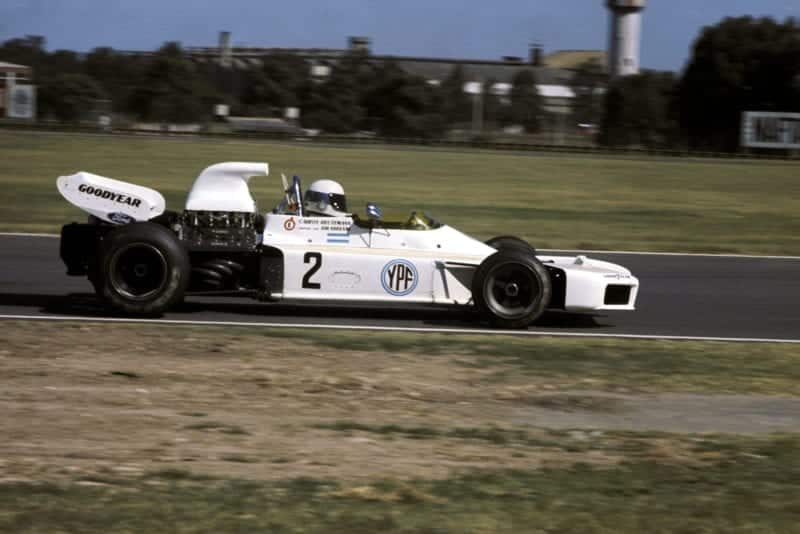
Hometown hero Carlos Reutemann took pole for Brabham
Motorsport Images
Official practice started on Friday but the circuit was open on the previous day and almost everyone availed themselves of the chance to find out the way round and select gear ratios. Amon’s hard luck story had started already as a small fault was found with the engine, which had to be removed for it to be repaired, while Walker and Wisell were the only two instructed to sit the session out. Stewart seemed to be in trouble with an ignition fault on the Tyrrell and this, apparently very good engine, had to be changed. The McLarens and Ferraris were the most impressive and the unofficial fastest seemed to be Regazzoni at about 1 min. 15.7 sec. This was the first time the No. 9 circuit had been used with the chicane before the pits and another in the infield section, so there wasn’t a record time to aim at.
The sessions on Friday and Saturday were both scheduled to stretch over four hours, from 3 p.m. and with a break of an hour somewhere along the way. The organisation was of a higher standard than expected, the main criticism being the lack of communication between race control and teams rather than anything else. Friday’s session got under way rather late but after that things improved. The electronic timing of the cars proved to be very accurate and there were no complaints at all on that score. These were soon reflecting that the McLaren team were all out to make an early impression, with both Revson and Hulme showing well in the first two hours with the chase led by Stewart and Reutemann, already giving a sign of something to come. Ferraris, meanwhile, had decided to complete their full tank tests first so they did not show up well until the closing, and slightly cooler, hour.
At the end of the day Ickx was very satisfied to finish up fastest for Ferrari at 1 min. 13.50 sec., although Hulme was close behind at 1 min. 13.56 sec. Both Stewart and Andretti had also got under the 1 min. 14 sec. barrier while Regazzoni had just missed out. Amon’s troubles seemed to be over for he was sixth fastest just ahead of Fittipaldi and Revson, who had an engine blow up in the closing stages. Schenken was very pleased with the Surtees, which he had not tried prior to arriving in Argentina, and de Adamich was also happy with his TS9B being close on Schenken’s heels.
Things were not nearly so promising in the BRM camp for the designer and team manager were finding it very hard to keep five drivers happy, particularly when they all came into the pits at the same time. The P160s were tending not to handle too well while Gethin’s car overheated and damaged an engine. In fact, the two older P153s were the quickest BRMs and they were well down the list. March Engineering had a rather different problem for, when Peterson woke up on Friday morning, he felt extremely ill and a glandular infection was diagnosed. However, despite doctors suggesting he stay in bed until after the weekend, he struggled to the circuit and did a few off-colour laps but was in no condition for motor racing.
Saturday brought huge crowds to the circuit and they were no doubt hoping to see Reutemann up amongst the leading times – they were not disappointed. The first session had not been going more than half an hour when it was halted so that the Matra, which had ground to a halt with gearbox trouble, could be towed in. This put quite a few people off their stride and when the session was over it was Stewart who came out top at 1 min. 13.61 sec., still slower than Ickx’s best. The engines of the Stewart and Cevert cars had been swapped round in the night which, strangely, seemed to benefit both of them. Fittipaldi had improved considerably and looked impressive, while Peterson felt much better and his times reflected this but Schenken missed the session completely due to a snag with a morning engine change.
As is so often the case, the last hour of practice brought the fireworks, with both McLarens and Stewart making the fast running. Meanwhile, Reutemann had also been lapping impressively in the 1 min. 13 sec. bracket and with twenty minutes to go he was despatched to have a real go. Looking remarkably unhurried he gave a Clark-like performance – his fourth lap was a sensational 1 min. 12.46 sec. and he came straight in with an unflustered yet knowing look. Quite a number of the pits had timed this fast lap and McLarens and Tyrrell in particular beckoned their men on while the Argentinian sat on the pit counter and just watched. Peterson would liked to have had a go too but had a brake problem, while the Ferraris also had little problems which prevented an all out effort. On his very last lap Stewart almost did it, but not quite and he stopped the clocks at 1 min. 12.68 sec. Revson showed that he is a very welcome addition to the Grand Prix scene by lapping in 1 min. 12.74 sec. to take third fastest time just ahead of team-mate Hulme. Fittipaldi and Regazzoni were the next two up and the whole grid was covered by an astonishing 3.2 sec., showing just how hard some of the tail-enders had been trying to keep in the running.
Reutemann’s fantastic effort had completely eclipsed the efforts of team-mate Graham Hill who had knocked a suspension corner off the previous day but finally qualified 16th fastest in amongst all the unhappy BRM people. Amon completed his practice by clonking in with another broken gearbox.
When the official times were announced the cheering was fantastic and Carlos Reutemann, in his third ever Formula One race and first ever Championship race, had qualified for pole position in his home Grand Prix – a rare feat indeed and one that assured the promoters that the whole of Argentina would be riveted to his progress in the race. The one cloud that hung over some of the fast times was the probability that some of them had been done on Goodyear tyres that would not see the race through. The Wolverhampton firm had brought along five separate compounds (against the rival Firestone’s one) but some were very soft for the boiling hot conditions.
Race
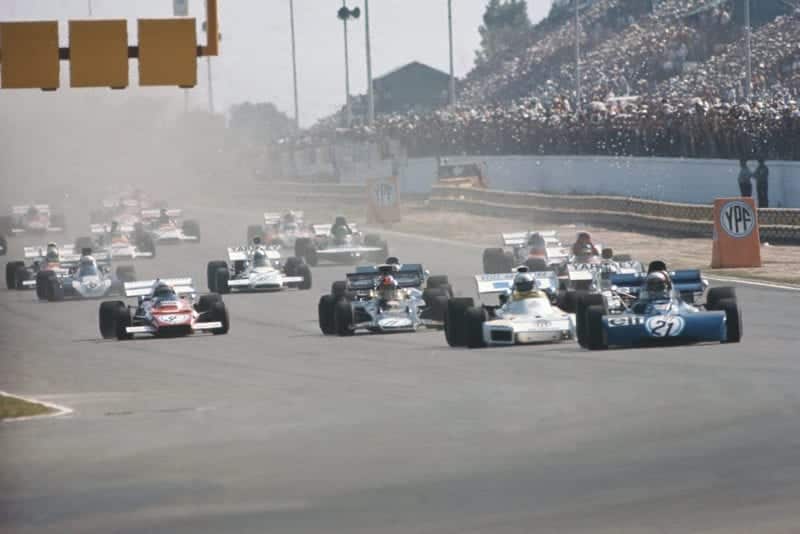
Stewart takes the lead at the start
Motorsport Images
The race was not scheduled to start until 4.30 p.m. on Sunday but by early morning a vast and excited crowd estimated variously between 70,000 and 100,000 poured into the Autodrome. It was very much a Cup Final atmosphere and with no other supporting events or attractions the race fans waited patiently in the burning hot sun, occasionally breaking out into chants of “Argentina, Argentina” or “El Lole, Lole, Lole”, which is Reutemann’s nickname. Tension gradually built up and the stands rocked as the white and yellow Brabham BT34 was rolled out to the pit front, and when Reutemann led the others off on the warming-up lap there were fantastic scenes as thousands of pieces of paper were flung into the air. At the end of the warming-up lap Amon rushed straight into the pits to complain, in no uncertain terms, that he could only get three gears and he did not take up his position on the grid. Something was definitely wrong with Andretti’s engine and mechanics worked feverishly on the grid to fix it. Peterson still did not feel 100% and now Revson was feeling under the weather too, and the pair of them had been given anti-biotics.
Right on the dot of 4.30, and with the President of the Argentine Republic amongst the vast crowd, the blue and white national flag was dropped and the race was on, the cars disappearing in a cloud of dust towards the first and fast right-hander. As they left the line Reutemann had just beaten Stewart away but, as 2nd gear was snatched, the Scotsman pulled ahead and led into the bend. Further back there was some hairy motoring and Hill was elbowed out into the rough and scattered a lot of grit and dirt over those following. Both Wisell and Walker found this had the effect of jamming their throttles and, while the Swede loosened his with a big kick on the pedal, and a resolution to go straight to the pits to have it checked, Dave Walker ground to a halt. He later ran to the pits to fetch a hammer and a can of WD40 and did in fact free the throttle slides. He actually rejoined on lap 22 only to be disqualified a little later for using tools not carried in the car. Wisell lost a couple of laps in the pits and after a spirited drive finally had to retire with a split water hose.
The main race, however, was between Stewart and Reutemann, then came Hulme, Fittipaldi, Regazzoni, Peterson, Cevert and Revson, who had made a poor start. Schenken headed the rest, who were reduced by two on the second lap. First Soler-Roig had his throttle stick open on the fast Ascari curve and before he had sorted it all out he had clobbered a barrier and written off the new BRM. Seconds later Peter Gethin was spinning his BRM to a halt at the hairpin, apparently after a nudge from behind, and the resultant drama knocked off an oil pipe and some electrics. So after two laps Marlboro-BRM had two cars damaged out of the race and another in the pits!
Up at the front Stewart was not pulling out his customary quick lead, for Reutemann was shadowing his every move and really set the crowd on edge on a couple of occasions when he tried to pass. But Stewart is not World Champion for nothing and he was having none of this. Fittipaldi was in his stride now and, by lap five, had passed Hulme and was closing on Reutemann. Regazzoni, in fifth place, had dropped back slightly from the front four and was having to fend off Peterson, Cevert, Revson and Schenken. Ickx was starting to pick up after a slow start but team-mate Andretti’s engine was definitely off-song and spitting out flames from the exhaust. He started to make a series of pit stops but these failed to cure the trouble and he soon retired after being black flagged because of the flames from the exhaust. Hill was another early retirement with a broken drive to his mechanical fuel pump and de Adamich retired about the same time, also with engine trouble.
Out at the front Argentinian hopes were starting to fade and so, apparently, were the super soft Goodyear tyres on which Reutemann was running. On lap 8 Fittipaldi moved into second place and set off after Stewart and, on lap 11, Hulme put Reutemann back to fourth place. All eyes were now on Fittipaldi for he started to close the gap on Stewart to within a couple of seconds but the Scot answered the challenge and started to increase the lead again. By lap 20 Stewart had a 4-sec. lead over Fittipaldi, with Hulme third about 3 sec. down. Reutemann was holding his fourth place but Regazzoni was coming under a lot of pressure from Cevert and also team-mate Ickx, who had made up his early deficit, and had Peterson on his tail although the Swede had lost 4th gear which made things difficult. Revson was also closing on this bunch while Schenken had slipped back a bit trying to change gear now that the lever’s knob had come off in his hand.
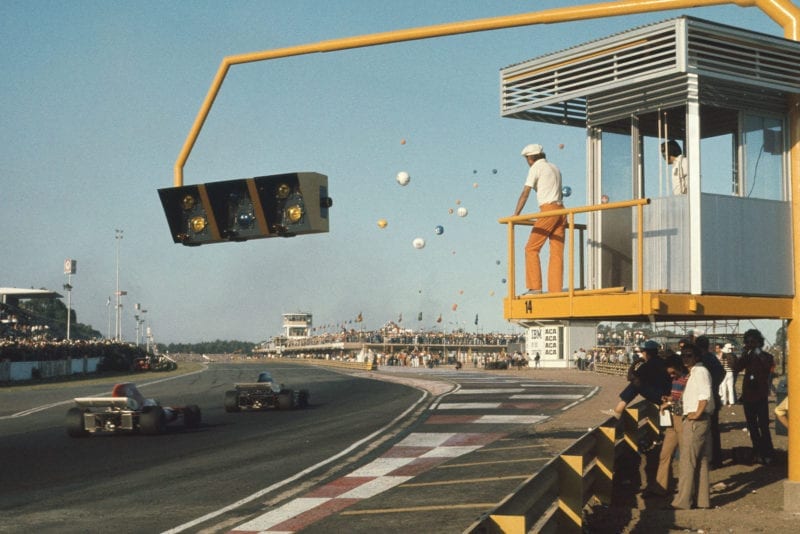
Henri Pescarolo chases March team-mate Ronnie Peterson at the 1972 Argentine Grand Prix
Motorsport Images
By lap 30 Stewart had thrown off the threat of Fittipaldi who now seemed to be having trouble selecting 4th gear, and Hulme started to close the gap and actually moved up to second on lap 35. Cevert was now running very strongly in fourth place and had closed right up on Reutemann by lap 45. At that point the Argentinian rushed into the pits and it could be seen that his right rear tyre had lost much of its rubber and both rears were replaced. He returned to the race down in 14th place while, just about the same time, Revson collected a shower of stones from Peterson on the right-hander after the pits and spun spectacularly. He restarted a few places down but in the process of the incident had knocked off a water pipe and he pulled in to retire a couple of laps later.
With half the 95 laps complete Stewart was now completely dominating the proceedings in true champion class and he had opened the gap over Hulme to about 15 sec. Fittipaldi was still third, but struggling with the gearbox, while Cevert looked strong in fourth place. Neither of the Ferraris in fifth and sixth places looked as if they had a chance of lasting, for though Ickx’s car had passed Regazzoni’s it was smoking very badly while Regazzoni had a piece of newspaper trapped up the nose which must have made the car overheat. It was, however, against the stone guard and the air pressure was punching holes through it and thus giving it just enough cooling air to bring the temperature gauge off the clock. The two Ferraris were running nose-to-tail with Peterson right with them too, but unable to find a way round.
The two Austrian newcomers, Marko and Lauda, were having their own private scrap for last place, the Le Mans winner throwing his BRM all over the place in an attempt to stay ahead of the March. Unfortunately, he mistook Peterson for Lauda at the hairpin on one lap and the Swede suddenly found that he had the door shut on him unexpectedly and nowhere to go, so he had to spin. He stalled the engine and fumbled for a few seconds restarting, and by that time the two Ferraris had disappeared into the distance and Schenken had moved up one. Around lap 60 there were two retirements, with Cevert going missing on the circuit, with the Tyrrell’s gearbox seized up, and then Fittipaldi pulling into the pits with a broken rear radius rod on the John Player car. Apparently at the start he got so much traction that it bent both top radius rods at a point where they taper, although Fittipaldi said that despite (or because?) of this the car had never handled better.
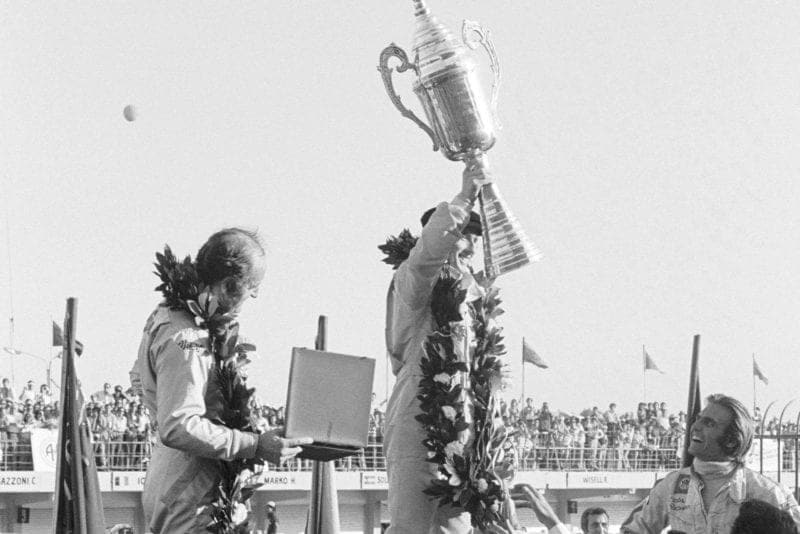
Jackie Stewart celebrates on the podium
Motorsport Images
So, with 30 laps remaining, Stewart was now romping around in the lead with 20 sec. over Hulme and actually shadowing a little group comprising the two Ferraris and Schenken who was now on their tail. Right behind Stewart, and no doubt collecting a good few tips, was Reutemann and as the group swept by Pescarolo the Argentinian moved up to seventh place. Thus the race ran out to a close with Stewart taking the chequered flag, still with Reutemann on his tail, with Hulme following 26 sec. behind. A further 34 sec. down Ickx’s still smoking Ferrari came home third ahead of team-mate Regazzoni who managed to fend off the challenges of a tiring Tim Schenken who nevertheless had given Surtees a good start to the year. Peterson had been lapped but was content to finish sixth in the circumstances, while Reutemann’s eventual seventh hardly does justice to a great performance and one which will surely be repeated. Pescarolo finished eighth, just 4 sec. ahead of Ganley, who had 13 sec. on the desperate Austrian dice, with Marko just holding off Lauda. The final five were all two laps down which, over 95 laps, is not a great deal for back-markers.—A. R. M.
